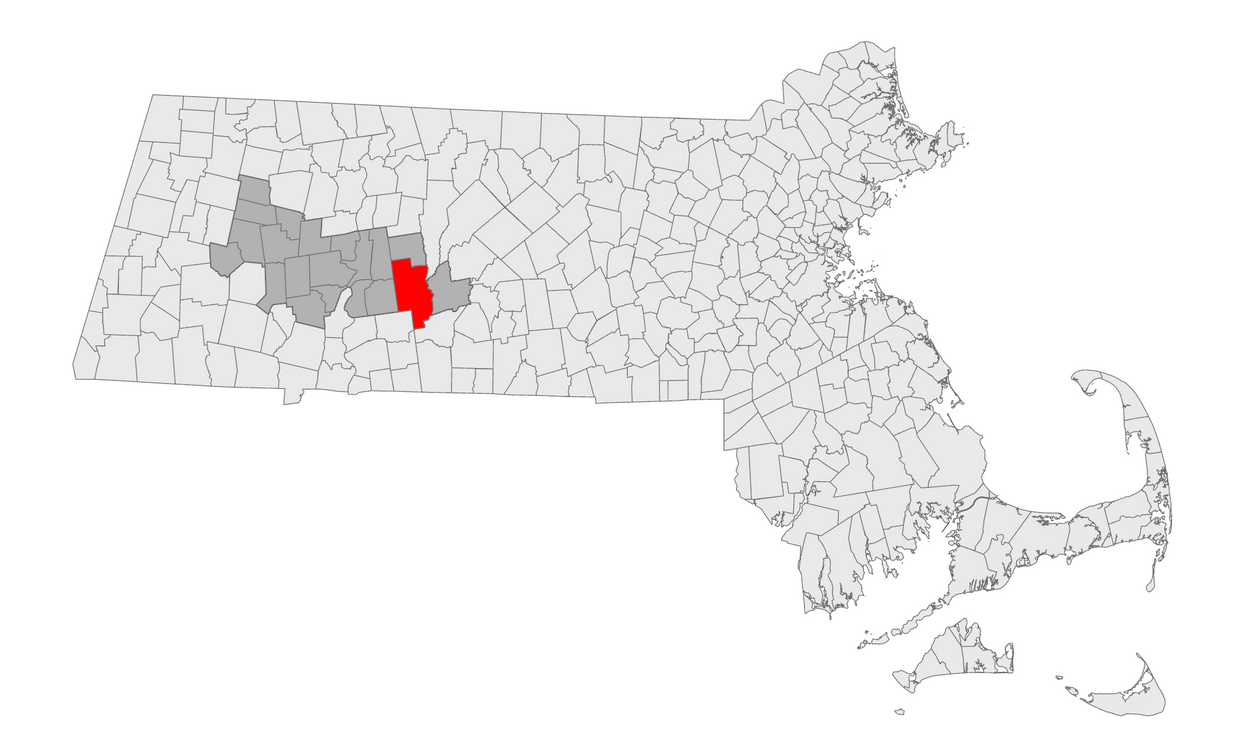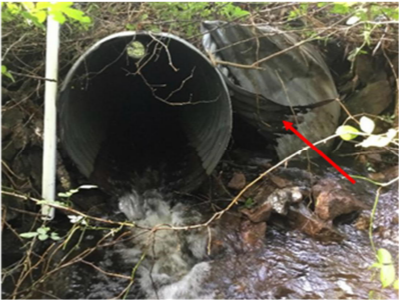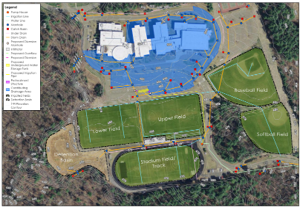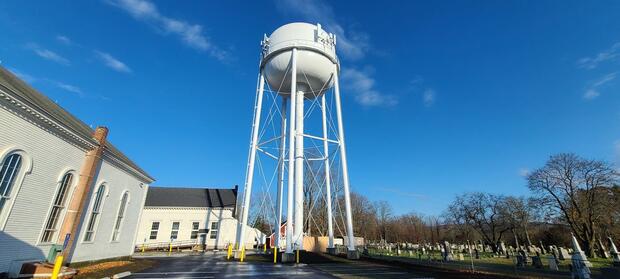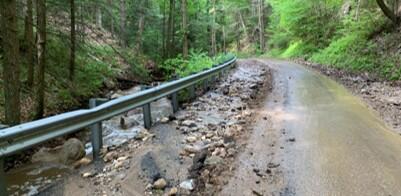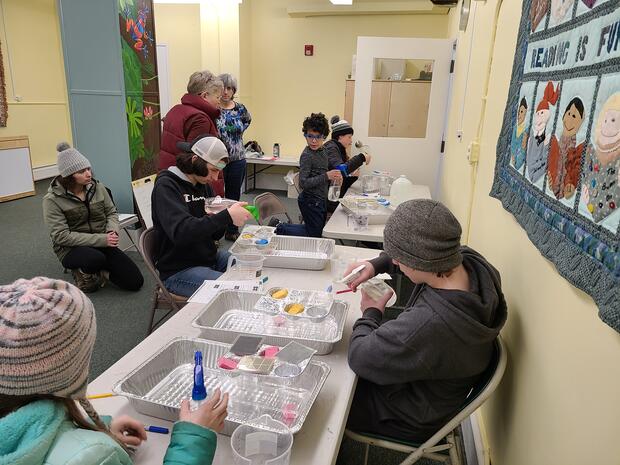Overview
Belchertown is a town in Hampshire County, Massachusetts, in the western part of the state. They have a population of 15,339 people and an area of 52.6 square miles. Climate hazards present in Belchertown include inland flooding, other severe weather, drought, and extreme temperatures.
Core Team
The MVP 2.0 Core team is a group of municipal staff and Community Liaisons who work together to identify local climate resilience priorities and implement a project that supports those priorities.
Belchertown's Core Team includes municipal representation from:
- Conservation Administrator
- Town Planner
- Senior Center Executive Director
- Clapp Memorial Library Director
- Select Board member
Community Resilience Priorities
Community resilience priorities are practical actions created during the MVP 2.0 Planning Grant process. They were shaped through community input, thoughtful discussion about changing local needs, and feedback from Environmental Justice groups and other community members.
Belchertown, in partnership with their Core Team, identified the following priorities through the MVP 2.0 process.
| Priorities | Potential Actions | ||
|---|---|---|---|
| Priority 1: Protect critical transportation routes to schools, healthcare facilities, essential workplaces through targeted flood resilience projects, prioritizing improved infrastructure along flood-prone corridors to ensure all-weather access for educators, care workers, and students. | Potential Actions: Actions could include but are not limited to upgrading the top problem culverts identified through the Town-wide culvert prioritization plan and incorporate nature-based solutions to address stormwater and erosion whenever feasible. Prioritize lower ranked culverts for replacement based on their conservation benefits, flood mitigation potential, community benefit and maintenance costs., re-establish connectivity and more natural flows along our rivers and streams by removing or modifying existing structural impediments, such as dams, and culverts, modify upstream flood control and water management infrastructure and the operation thereof to allow for regular flooding of floodplain forests where feasible. Develop a pavement management assessment and prioritization plan that includes the incorporation of green infrastructure and nature-based solutions into drainage design. | ||
| Priority 2: Encourage the preservation of agricultural lands and increase accessibility of healthy and affordable food, particularly for neighborhoods without a grocery store. | Potential Actions: Actions could include but are not limited to assisting farms in preparing emergency response plans, work with MCAD to identify on-farm adaptations for specialized products such as maple syrup or dairy., consider the need for access to new lands for expansion of maple sugar operations in the near term, to buffer orchards and dairy farms, and to allow for land to grow new varieties of fruit trees and dairy support crops; introducing a mobile food market, working with convenience stores to offer healthy foods and accept SNAP, creating a food delivery (including an e-cargo bike delivery program), and a food recovery program; supporting efforts for communities / smaller farms + smaller businesses; all of the identified hazards (flooding, drought, extreme temperatures, storm event s) have the potential to significantly impact agricultural production, with corresponding threats to livelihoods. Planning should address hazard resiliency as well as long-term plans to transition producers to new techniques and/or into new crops to replace crops/ industries that may no longer be viable due to climate change (e.g. maple sugar industry); building water conservation, collection, and irrigation resiliency: and coordinate an education and outreach program to encourage residential and agricultural best practices. | ||
| Priority 3: Identify and address vulnerabilities to drinking water. | Potential Actions: Actions could include encouraging private well owners with vulnerable well locations to seal well and to grout the space between the casing and bore hole and/or relocate the well on the property. Develop GIS database of private wells or parcels with wells. Track and communicate incidences of private water well failures with health departments especially in drought conditions. Encourage residents to sample their wells on an annual basis, especially following significant storm events. Encourage private well owners extend well casing above flood level if in a delineated FEMA flood zone or commonly known flooding area even if above 1ft above grade. Research possibility of solar-powered or hand-powered pumps for residents/facilities dependent on potable well water. Well depth will determine feasibility of different technologies. | ||
| Priority 4: Build and diversify housing options to make housing more affordable and climate resilient. | Potential Actions: Actions could include but are not limited to hiring a regional housing coordinator, develop and establish a housing trust, providing financial assistance, ensure housing options are safe, up to code, and accessible, provide assistance to allow residents to age in place, increasing access to affordable energy efficient heating and cooling systems, particularly in the building rehab program with a specific focus on retrofits for rental properties and informational campaigns about existing energy efficiency & weatherization programs. | ||
| Priority 5: Explore incentives and opportunities to update aging and failing wastewater and septic systems. | Potential Actions: Actions could include but are not limited to updating septic (subsurface disposal) systems for effects related to climate change and, where necessary, consider alternative on-site technologies considering green practices that may be more resilient to climate change impacts, especially the intensity of precipitation and stormwater effects on existing systems, amending local code to require systems near recreational lake assets have a phosphorus reduction. Establish a local fund to assist residents with septic upgrades. Work with the board of health, select board, and conservation commission to update existing septic system regulations including the design and permitting of soil absorption systems for potential accessory dwelling units; Install wastewater treatment plant upgrades to establish cold weather protections and maintain operations during extreme temperatures. | ||
| Priority 6: Strengthen and enhance the sheltering and transportation plan for vulnerable populations during hazardous (and disaster) events. | Potential Actions: Actions could include but are not limited to developing a voluntary, confidential special needs registry for residents with disabilities, chronic conditions, or special needs; identifying shelter locations outside of flood plains; explore “pet friendly” shelters, prepare for additional trauma due to dispossession, mental health challenges and post-traumatic stress disorder and ensure have mental health providers are staffed at shelters during the aftermath of extreme events,, and working with emergency responders to develop these plans. Develop communications for visitors and seasonal/permanent residents about evacuation routes and heating/cooling centers, and emergency shelter locations. | ||
| Priority 7: Build a resilience hub (community center) to strengthen community resilience and reduce social isolation. Work with town community groups to develop a “Resilience Hub”. | Potential Actions: Actions could include “Rainbow Cafes” to provide a safe space for LQBTQIA to gather and discuss community issues, “Memory Cafes” to provide a safe space for residents experiencing cognitive challenges along with caring family members, friends and professional caregivers with find meaningful programming, friendship, and acceptance. | ||
| Priority 8: Strengthen and promote the emergency management system for all residents. | Potential Actions: Actions could include the town developing a system to effectively get information out to all residents, even without power and, in case of emergency, or even under ii. ‘normal’ circumstances, allow residents to be able to communicate to the appropriate bodies when they need something. Especially helpful in case of emergency so if one neighbor doesn’t hear about an evacuation route, for example, their neighbors can share the necessary information with them. Hold opportunities to build community through workshops, training, and presentations on disaster preparedness. | ||
| Priority 9: Promote regional scale land protection, focusing on habitat resiliency. | Potential Actions: Actions include but are not limited to increasing the use of fire control techniques through controlled burns and selective regeneration projects (improves diversity in forest age and species composition). Include open patch habitat and closed canopy habitat within overall forest habitat. Promote habitat resilience by managing invasive species, in particular exotic insects including woolly adelgid, Asian longhorn beetle, emerald ash borer and gypsy moth. Plan for the impact of vectors like diseases and pests (e.g. avoid Ash trees in landscaping due to the Emerald Ash Borer). Develop invasive species management plans for municipal properties and encourage local nurseries to eliminate sale of invasive plants; Develop a comprehensive tree and forests management program to identify, remove, and replace problem trees; preserve intact forests and street tree cover; provide guidance and resources for gradually moving toward more climate-resilient trees and forest communities (e.g. species that will tolerate warmer temperature es); develop guidelines to manage conversion of forest land (e.g. solar guidelines); acquire open space consistent with Town planning priorities and focused on areas that will create flood resiliency through increasing storage capacity in floodplains and/ or infiltration capacity in uplands. | ||
| Priority 10: Improve safety and resiliency of mobile home communities. | Potential Actions: Actions could include but are not limited to improving water supply system to guard against drought; upgrading wastewater systems, developing a sheltering and evacuation plan, better anchoring of structures to prevent catastrophic damage due to wind and storm events. | ||
Belchertown's MVP 2.0 Seed Project: Establishing a Municipal Resilient Housing Trust
Belchertown received funding to implement a Seed Project that addresses one or more of their climate resilience priorities.
They plan on developing a housing trust bylaw that would make houses more climate resilient and cost-effective. Their goal is to ensure that the housing trust considers climate resilience and green technology as factors in funding projects and to make housing more accessible.
The activities of this project include:
- Develop and submit housing trust bylaw to Attorney General
- Establish a Board of Trustees and conduct community engagement to identify members representing key populations
- Establish annual reporting and public communications plan
- Identify housing priorities, including climate resilience and green energy technology
- Identify pilot project for implementation of priorities and operating approach
Belchertown's Action Grant Projects
The MVP Action Grant provides funding to communities that want to take important steps to prepare for climate change, such as dealing with extreme weather, flooding, rising sea levels, and extreme heat.
Town-wide Road Stream Crossing Assessment and Climate Change Adaptation Plan (FY18)
The Town of Belchertown identified and provided recommendations and concept designs for high priority crossings to enhance community resilience, mitigate existing and potential flooding, and increase stream continuity and aquatic passage. The project also provided recommendations for areas that are known to be heavily influenced by beaver activity.
Enhancing Water Supply Reliability: Resilient Water Storage & Water Conservation Planning (FY19)
The Town of Belchertown and the Belchertown Water District designed and permitted for a replacement water storage tank that would increase storage capacity and resiliency to drought, and completed a feasibility/concept design of a rainwater harvesting system at Belchertown High School to irrigate the athletic fields. Read this projects MVP Case Study.
Enhancing Water Supply Reliability: Resilient Water Storage and Water Conservation – Design & Implementation (FY21)
In a continuation of a previous MVP Action Grant, the Town of Belchertown and the Belchertown Water District replaced the Park Street water storage tank with a new tank to increase storage capacity and resiliency to drought. The tank replacement project included improvements to the municipal parking lot adjacent to the tank, which incorporated green stormwater practices to enhance water quality and provide significant opportunities for public education and outreach at this highly visible site in the Town center. The Town and the Water District also pursued detailed design and permitting for a rainwater harvesting system at Belchertown High School to irrigate the athletic fields, to reduce public water use during periods of peak demand. Read this projects MVP Case Study.
Land Conservation and Restoration of the Scarborough Brook Headwaters for Climate Resilience (FY22)
Belchertown conducted a multi-pronged project focused on the headwaters of the Scarborough Brook watershed and the Scarborough Brook Conservation Area (SBCA) to increase habitat and water supply resilience under future climate conditions. Read this projects MVP Case Study.
Scarborough Brook Watershed Improvements (FY23)
Belchertown proposed a second phase to build on the FY22 Action Grant project, which was focused around Upper Scarborough Brook and the Scarborough Brook Conservation Area (SBCA) to restore a cold-water fishery resource and protect the Daigle aquifer and downgradient Lawrence Swamp aquifers. Under the FY22 grant, the Town is conducted feasibility studies for removal of the upper and lower dams within SBCA and completing preliminary design plans to replace the two uppermost downstream culverts. In FY23 the Town sought a grant to complete detailed design and permitting to move the project forward to implement the culvert replacements and dam removals to promote flood resilience and simultaneously improve access to the already-preserved habitat corridor as part of a systematic long-term program of improvements along the entire stretch of Brook.
Hop Brook Culvert Replacement (FY26)
Funding was requested for the construction phase of a culvert replacement project for the crossing at Warren Wright Road and Hop Brook. The existing crossing consists of 3 round corrugated metal pipes with severe condition deficiencies: the pipes are partially filled with sediment and routinely submerged due to beaver activity, despite the presence of a flow-control device/pond-leveler installed in the downstream beaver dam. The crossing has been identified as among the top 5% of crossings prioritized for replacement by the Mass Wildlife Climate Action Tool and is located along a stream that is mapped as a coldwater fishery resource, and links two pieces of conservation property and is part of a larger corridor in Belchertown that provides important habitat connectivity and provides recharge to the Daigle aquifer and Lawrence Swamp aquifer. The proposed replacement structure will be an open-bottom structure, approximately 23 feet wide by 8 feet high, with an additional adjacent structure (9 feet by 3 feet) for terrestrial passage and additional hydraulic capacity during larger storm events.
